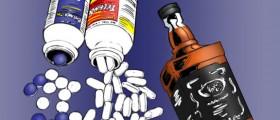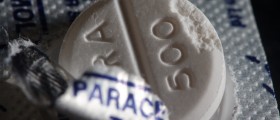
The pathophysiology of dental pain is a complex process of the central and peripheral nervous system and sometimes the combined use of analgesics can give the best results in relief from toothaches.
Acetaminophen is a nonnarcotic pain reliever and is usually used for mild to moderate pain. It relieves pain as well as fever, it works quickly, but does little against inflammation. If a person takes a very high single dose it may cause damage to the liver. Doses of 500 to 650 milligrams usually last for one hour. A dose of 1,000 milligrams can last up to four hours for pain relief. Acetaminophen is generally good for the short-term relief of mild dental pain.
NSAIDs are used traditionally to treat moderate pain as well as inflammation. NSAIDs like ibuprofen, Aspirin and their various derivatives usually relieve local pain. Using NSAIDs on a long-term basis can damage kidneys, cause bleeding and cardiovascular and gastrointestinal problems. All of them also interact with some high blood pressure drugs in a bad way. Short-term side effects are usually stomach-oriented problems. A higher dose is usually required for the best results. Three doses a day of 800 milligrams has proved to be sufficient. NSAIDs act slowly and last for about four hours. COX-2NSAIDs were developed for the limitation of adverse effects that the NSAIDs sometimes seem to have.
Some other pain relievers exists, but they are narcotics.
Opioids are agents that act on the central nervous system, and some of them are not that efficient in relieving dental pain. The risk of side effects varies, but dizziness, sedation, nausea and constipation are among the common ones. Tramadol is a synthetic reliever that acts centrally as well and it is used for moderate to moderately severe toothaches. Side effects are similar to those of the opioids but there is also a possibility of developing a substance dependence as well. Tramadol is often used in post-operative situations and it provides a numbing pain relief for up to six hours after surgery and responds to dosage effectively.
Benzodiazepines serve a multiple purpose by decreasing anxiety and sedating and reducing the sensitivity to painful stimuli.
Midazolam provides memory blockage and so-called surgical amnesia for about half an hour. It is usually given to children 10 minutes before the surgery in order to avoid the post-operative negative effects.
Diazepam deals with oral pain in association with muscle spasms, but a great abuse of this substance should be avoided, because there is a great potential of developing a dependence for it. Cardiopulmonary monitoring is required when Diazepam is used in combination with opioids for conscious sedation.















,-Or-Ibuprofen-Which-Over-The-Counter-Painkiller-Should-You-Choose_f_280x120.jpg)
Your thoughts on this
Loading...